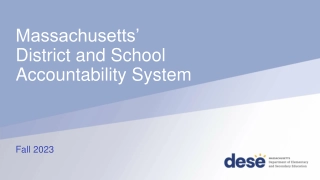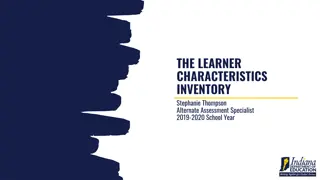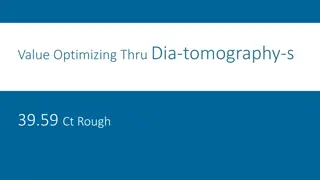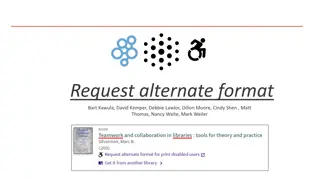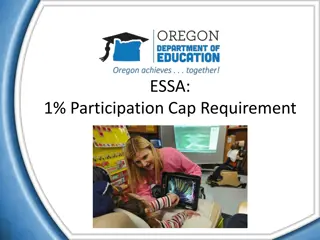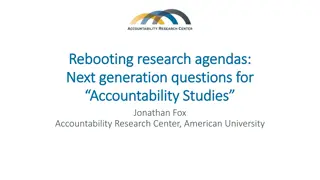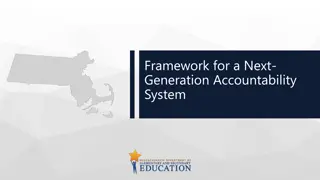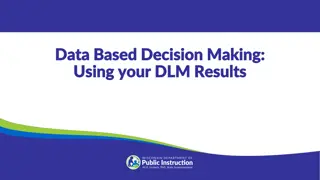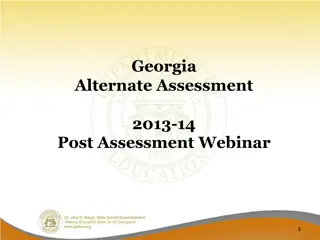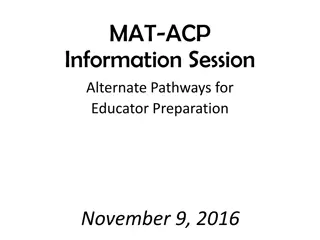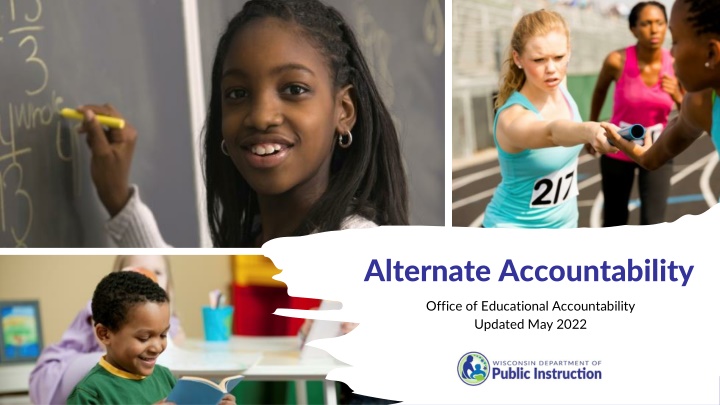
Alternate Accountability in Education
Alternate Accountability provides a district-supervised self-evaluation process for schools to assess their performance in key areas aligned with School Report Cards. This evaluation process helps schools improve in student achievement and success indicators while meeting federal accountability requirements.
Download Presentation

Please find below an Image/Link to download the presentation.
The content on the website is provided AS IS for your information and personal use only. It may not be sold, licensed, or shared on other websites without obtaining consent from the author. If you encounter any issues during the download, it is possible that the publisher has removed the file from their server.
You are allowed to download the files provided on this website for personal or commercial use, subject to the condition that they are used lawfully. All files are the property of their respective owners.
The content on the website is provided AS IS for your information and personal use only. It may not be sold, licensed, or shared on other websites without obtaining consent from the author.
E N D
Presentation Transcript
Alternate Accountability Office of Educational Accountability Updated May 2022
New in 2021-22 (NEW) Easier submission to DPI! Both the school principal and district administrator certification checkboxes appear alongside each other on the same form. Please ensure that the school principal and district administrator approve of the responses at the time of submission.
What is Alternate Accountability? Alternate Accountability is a district supervised self-evaluation process. Schools reflect on their school goals and self-assess their performance in three priority areas aligned to the School Report Cards.
What is Alternate Accountability? Schools evaluate their performance in three priority areas: raising student achievement in reading raising student achievement in mathematics preparing students to be on-track for success
What is Alternate Accountability? These priority areas align to those found in the School Report Cards, but also fulfill federal accountability requirements from the US Department of Education (USDE).
Who Participates? Schools that were new in the 2021-22 school year Schools without tested grades, such as K-2 schools Schools with fewer than 20 full academic year (FAY) students tested in grades 3-8 and 11 or grades 3-11 in 2021-22 Schools with fewer than 20 FAY students tested in grades 3-11 in 2020-21
What Data are Used? Schools may use local data and indicators of their choice to gauge student progress in the priority areas.
What Data are Used? New schools that do not have data from a prior year should select an indicator that can measure student progress from Fall 2021 to Spring 2022. Schools that have multiple years of data may choose to measure progress from fall to spring or from the prior to current school year.
How are Goals Measured? English Language Arts - schools may use measures of attainment, growth, and/or closure of achievement gaps. Mathematics - schools may use measures of attainment, growth, and/or closure of achievement gaps. On-Track for Success - schools may use measures of graduation or attendance.
What Does the Process Look Like? Describe school goal Describe measure used to evaluate goal Summarize progress toward goal Example: Our goal was to reduce the number of students scoring Below Basic (move students to Basic and above) in mathematics. Example: We used the MAP test to determine the percent scoring Below Basic, Basic and Proficient in math in fall and spring Example: The percentage of students scoring Below Basic in math decreased from 31% to 18% from fall to spring.
Completing the Form 1. Open link to unique form sent to school principal. 2. Describe goals, measures used, and progress toward goal in each of the priority areas. 3. Assign a performance rating. 4. Select an accountability rating. 5. Certify the form.
Performance Ratings Mathematics Maintaining/Improving On Track for Success Maintaining/Improving English Language Arts Maintaining/Improving or or or Declining Declining Declining
Accountability Rating Mathematics Maintaining/Improving On Track for Success Maintaining/Improving English Language Arts Maintaining/Improving or or or Declining Declining Declining Alternate Rating - Satisfactory Progress or Alternate Rating - Needs Improvement
Form Submission The Alternate Accountability Determination Form is an electronic form from Qualtrics. (Optional) Complete responses using blank form found on OEA s Alternate Accountability site and gather approvals. Type responses into the form. Certify the form. Forms for the 2021-22 school year may be submitted anytime between May and September. The due date is September 13, 2022.
Further Information Alternate Accountability Resources: http://dpi.wi.gov/accountability/alternate-accountability Alternate Accountability Questions: oeamail@dpi.wi.gov

